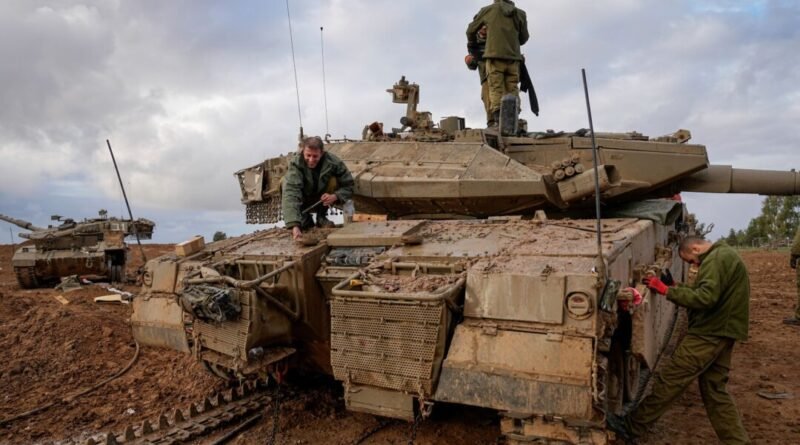Israel and Hamas Prolong Ceasefire, but War May Be Imminent.
Tel Aviv, Israel – A truce between Israel and Hamas entered its fifth day on Tuesday, with the terrorist group promising to release more hostages to delay the expected resumption of the war and Israel under growing pressure to spare Palestinian civilians when it renews its offensive. The sides agreed to extend their truce through Wednesday, with another two planned exchanges of terrorist-held hostages for Palestinians imprisoned by Israel. But Israel has repeatedly vowed to resume the war with “full force” to destroy Hamas once it’s clear that no more hostages will be freed under the current agreement’s terms. U.S. Secretary of State Antony Blinken is set to visit the region later this week for the third time since the start of the war, and is expected to press for an extension of the truce and the release of more hostages. The Biden administration has told Israel it must avoid “significant further displacement” and mass casualties among Palestinian civilians if it resumes the offensive, and that it must operate with more precision in southern Gaza than it has in the north, according to U.S. officials. The officials spoke on condition of anonymity under ground rules set by the White House. Meanwhile, U.N. Secretary-General Antonio Guterres reiterated his call for a long-term cease-fire and the release of all hostages, reflecting broad international support for a halt to the deadliest round of Israeli–Palestinian violence in decades. Hamas and other terrorists are still holding about 160 people, out of the 240 seized in their Oct. 7 assault into southern Israel that ignited the war. That’s enough to potentially extend the truce for another two weeks under the existing framework brokered by Qatar, Egypt, and the United States, but Hamas is expected to make much higher demands for the release of captive soldiers.
Related Stories Israel has vowed to end Hamas’ 16-year rule in Gaza and crush its military capabilities. That would almost certainly require expanding the ground offensive from northern Gaza—where entire residential areas have been pounded into rubble—to the south, where hundreds of thousands of displaced people have packed into overflowing United Nations shelters. Israel blames the soaring casualty toll on Hamas, accusing the terrorists of using civilians as human shields while operating in dense, residential areas.
Hostages and Prisoners Released
Monday’s release brought to 51 the number of Israelis freed under the initial four-day truce, along with 19 hostages of other nationalities. So far, 150 Palestinians have been released from Israeli prisons. Israel has said it would extend the cease-fire by one day for every 10 additional hostages released. A group of Israelis celebrate as a helicopter carrying hostages released from the Gaza Strip lands at the helipad of the Schneider Children’s Medical Center in Petah Tikva, Israel, on Nov. 26, 2023. (Leo Correa/AP Photo) The Palestinian prisoners released so far have been mostly teenagers accused of throwing stones and firebombs during confrontations with Israeli forces. Some were convicted by Israeli courts of attempting to carry out deadly attacks. Most of the freed hostages appeared to be physically well, but an 84-year-old woman released Sunday was hospitalized in critical condition because she had not had access to her medication in captivity. They have mostly stayed out of the public eye, but details of their captivity have started to emerge.
In one of the first interviews with a freed hostage, 78-year-old Ruti Munder told Israel’s Channel 13 television that she was initially fed well in captivity but that conditions worsened as shortages took hold. She said she was kept in a “suffocating” room and slept on plastic chairs with a sheet for nearly 50 days. Israel imposed a total siege on Gaza at the start of the war and had only allowed a trickle of humanitarian aid to enter prior to the cease-fire, leading to widespread shortages of food, water, medicine, and fuel to power generators amid a territory-wide power blackout.
Northern Gaza in Ruins
The cease-fire has allowed residents who remained in Gaza City and other parts of the north to venture out to survey the destruction and try to locate and bury relatives. Footage from northern Gaza, the focus of the Israeli ground offensive, shows nearly every building damaged or destroyed. A Palestinian walks in Gaza City on Nov. 27, 2023. (Mohammed Hajjar/AP Photo) A U.N.-led aid consortium estimates that over 234,000 homes have been damaged across Gaza and 46,000 have been completely destroyed, amounting to around 60% of the housing stock in the territory, which is home to some 2.3 million Palestinians. In the north, the destruction of homes and civilian infrastructure “severely compromises the ability to meet basic requirements to sustain life,” it said. More than 13,300 Palestinians have been killed since the war began, roughly two-thirds of them women and minors, according to the Health Ministry in Hamas-ruled Gaza, which does not differentiate between civilians and combatants. More than 1,200 people have been killed on the Israeli side, mostly civilians killed in the initial attack. At least 77 soldiers have been killed in Israel’s ground offensive. Israel says it has killed thousands of terrorists.
Fears for the South
Israel’s bombardment and ground offensive have displaced more than 1.8 million people, nearly 80% of Gaza’s population, with most having sought refuge in the south, according to the U.N. humanitarian affairs office. Israeli troops have barred people from returning to the north during the cease-fire. Hundreds of thousands of people have packed into U.N.-run schools and other facilities, with many forced to sleep on the streets outside because of overcrowding. It’s unclear where they would go if Israel expands its ground operation, as Egypt has refused to accept refugees and Israel has sealed its border. The U.N. says the truce made it possible to scale up the delivery of food, water, and medicine to the largest volume since the start of the war, and to bring in desperately needed fuel for homes, hospitals, and water treatment plants. But the 160 to 200 trucks a day is still less than half what Gaza was importing before the fighting, even as humanitarian needs have soared. Four days into the truce, residents were still waiting for hours to buy gas and cooking fuel. Juliette Toma, a spokesperson for the U.N. agency for Palestinian refugees, said people come to shelters asking for heavy clothes, mattresses and blankets, and that some are sleeping in damaged vehicles. “The needs are overwhelming,” she told The Associated Press. “They lost everything, and they need everything.”
Source link




